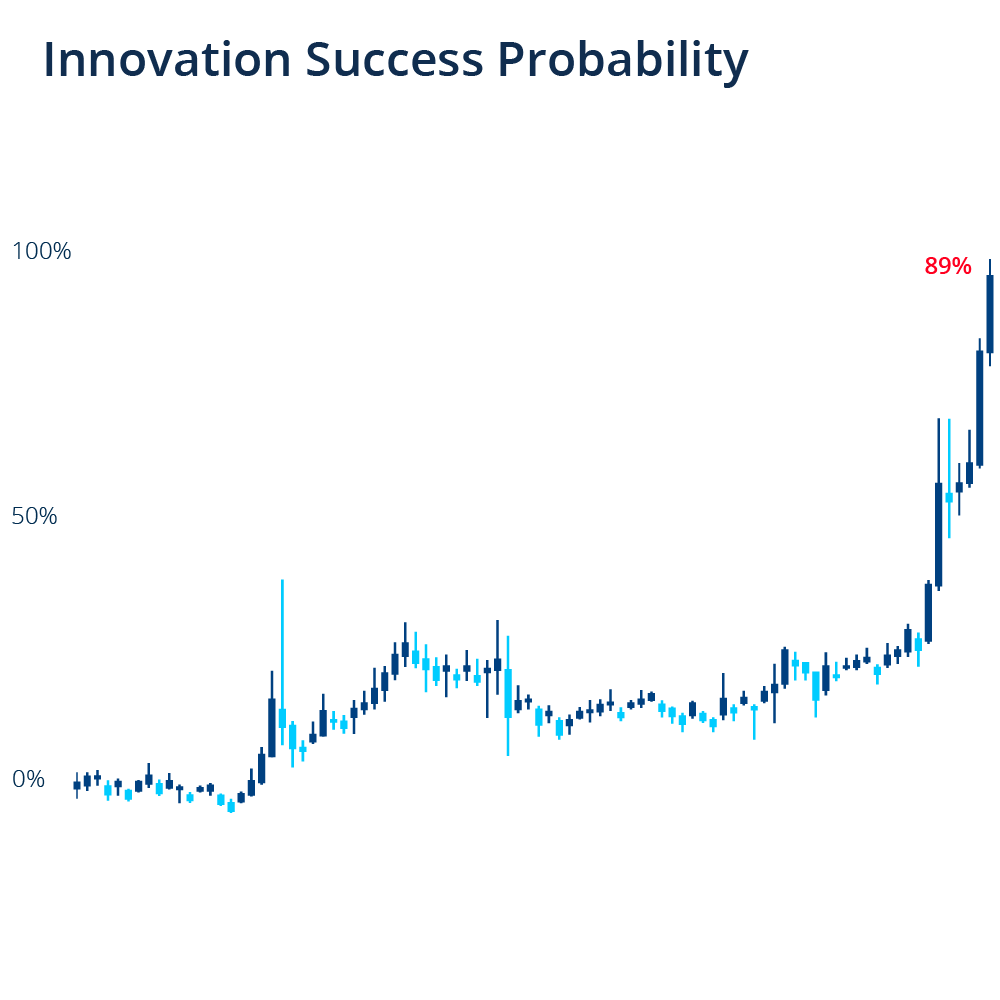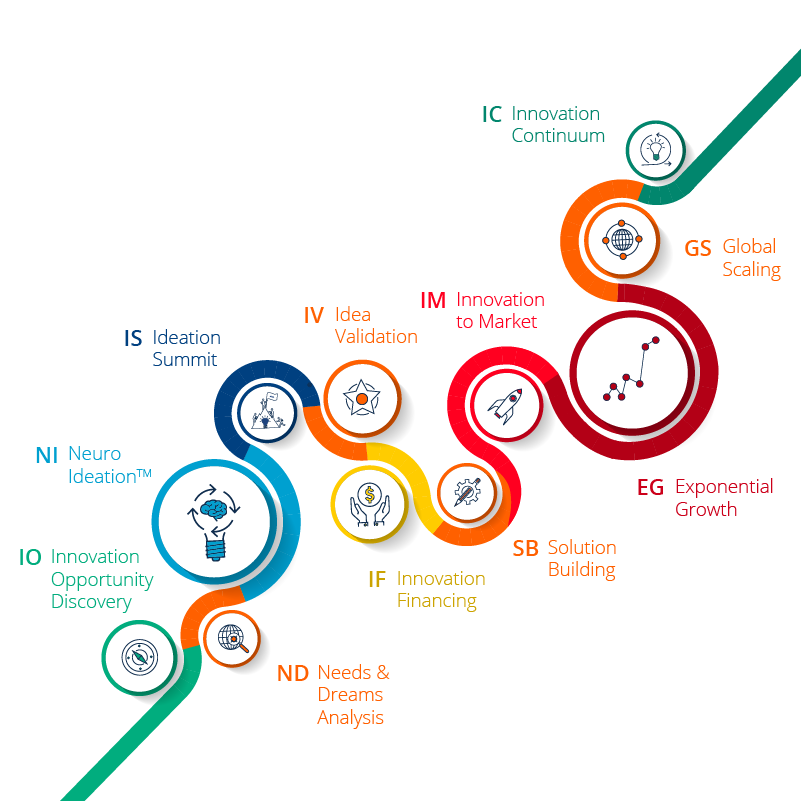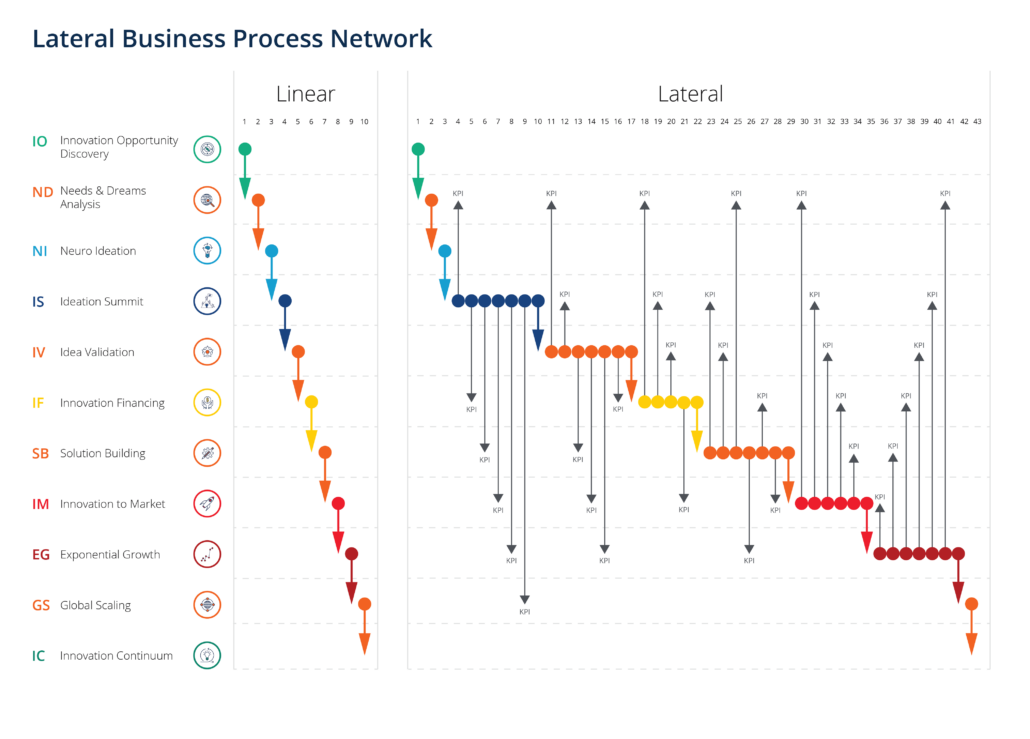Innovation KPI Framework™
Making Innovation Success Predictable
Intelligent Innovation KPI-Framework
Empowering teams to be more creative by delegating administration and process management to an AI
Creativity and process management seems to be mutually exclusive
Brilliant minds are typically not so sharp in administrative work and vice versa. But with a lack of KPIs, reporting, data administration, it’s almost impossible to get an innovation concept approved, funded, and able to succeed in a hyper-competitive market.
- What if we can delegate all the administration to an artificial intelligence solution?
- What if that solution could even amplify creativity through intelligent user guidance?
- What if the data could predict an innovation success with reasonable accuracy?
- What if management could accompany the process by reviewing KPIs in real-time?
- What if all that could lead to automatic report generation?
What seemed to be an unrealistic dream just two years ago is possible today.
The BlueCallom DEEP Technology was designed to take KPI data from every step of a journey. That way, the AI-System can manage all data, analyze and cross-reference inputs, automatically produce reports, and much more. Results are displayed in real-time as they get aggregated or changed throughout the innovation journey. The innovation teams see the results in their workspaces and executives on their dashboards.
A billion-dollar innovation needs predictability
BlueCallom’s AI-driven Innovation KPI Framework
Intelligent Data Analysis
Time is money – Data is intelligence
Data from every step of the way
Automated data aggregation = zero data administration
What innovation teams had to do manually in the past is now automated.
We are aggregating roughly 20,000 data points during an innovation journey. Every episode in the innovation journey, from identifying certain innovation opportunities until such innovation was created, produced, and scaled in the designated market provides highly valuable data – now automatically.
Whether you use the Deep Innovation Design methodology set, or add other methods like Design Thinking, Stage-Gate, Horizon, TRIZ, Agile, Six Sigma or design your own, The KPI-Framework is architected in a way that you can use its roughly 800 “activities – sensors” to feed the intelligent KPI-Framework
During the roughly 10 episodes of research, ideation, validation, financing, producing, introducing, and scaling, a team of 10 produces thousands of idea pieces, research, customer feedback, and opinion that are ranked and rated by that team. Cross correlations are built by the AI, time is tracked in the background and budget alignments may have been necessary by the team manager. Team quality is measured by the strength of the team’s cognitive abilities and possibly readjusted during the process. Customer validation and product reviews during the process and MVP tests in between provide a rich base to compute a probability of success.
Time, budget, and ROI are only a small part of the entire data lake. Of course, they are of major importance as a result – but to manage a team to get there, the real innovation-specific data are the coordinates to get there.
Innovation is no linear, step-by-step process
Lateral thinking is done by the AI
During an innovation process, innovation teams will want to look back and review what customers said about their needs or what the team decided to do or not to do. But the innovation team will also continuously look into the future. consider that a solution will need certain aspects to bring it to market. The team will consider the building process or the financing process early in the design. The lateral aspects of what may seem like a linear process contain twenty times as many considerations as most teams would be able to manage. Yet another reason to have an intelligent guidance system that as bycatch collect relevant data for the success predictability. AND – the team doesn’t even need to care.
Non-linear behavior was seen early on in Design Thinking. It was later established in Stage-Gate as an option to go back.
When BlueCallom is used as a STAGE-GATE engine, users can go back and forth and do not confuse the process. The full KPI framework remains active and all data predict also here the probability of success.
Laterality Support for KPIs
A framework that grows
Inside the BlueCallom Innovation KPI Framework
The hidden champions of the KPI Framework
BlueCallom Innovation KPI Framework Data Stack
A data structure that you don’t really see
ISI | Innovation Success Indicator
The ultimate and single KPI of an innovation journey. The ISI is giving managers the success indication of 0% to 95% probability of success. Of course, there is a remaining risk to be considered. The ISI exposes the predictability to be successful in an accuracy that was never achieved so far.
EPI | Episode Performance Indicator
Each innovation journey has various episodes like innovation opportunity discovery, ideation, validation, and so forth. Some of those episodes are better indicators, like customer validation than others. An algorithm computes predictability contribution levels, gives it weight, and adds to the overall ISI.
OPI | Operational Performance Indicator
During the innovation journey time, budget, ROI are important data to navigate a team and those data may change underway, or also the goals may be adjusted as teams need to move forward.
TPI | Task Performance Indicator
Diving deeper into details, EPIs are fed by their respective tasks, ideation, collecting customer feedback, or market research. The system considers quantitative values as well as qualitative values from rating and review processes. The roughly 120 innovation-specific tasks, which are product and industry or customer type, independent, produce roughly 1,200 datapoints with 2,400 values plus cross-correlation data.
LPI | Lateral Performance Indicator
Lateral processes across an entire innovation journey produce another roughly 200 performance data from backward and forward correlations.
UPI | User Performance Indicator
Indicate key insights about the quality of the team in particular the degree of diversity and the strength o their cognitive abilities.
DATA | Innovation relevant performance data
All the above innovation performance-specific xPI data are collected in the background without the team needing to feed any system.
Why are we so sure about the results?
- We know from neuroscience and also from our own experience as entrepreneurs, as well as experiences with startups we guided to groundbreaking innovation in the past years, that creating ideas is neither accidental nor random.
- Based on the understanding, of how our brain composes ideas, we are able to stimulate innovative ideas and come to groundbreaking ideas within four weeks on average. On the contrary, if a team can’t get to a groundbreaking concept within that approximately 4 weeks timeframe, it most likely never will. That makes genuine innovation even more predictable than improvements.
- However, we know that the initial value of an idea is zero. Despite its strategic importance, the value of an idea only grows with its distribution in the market. The duality of brilliant ideation and relentless execution is driving innovation success. One is nothing without the other.





